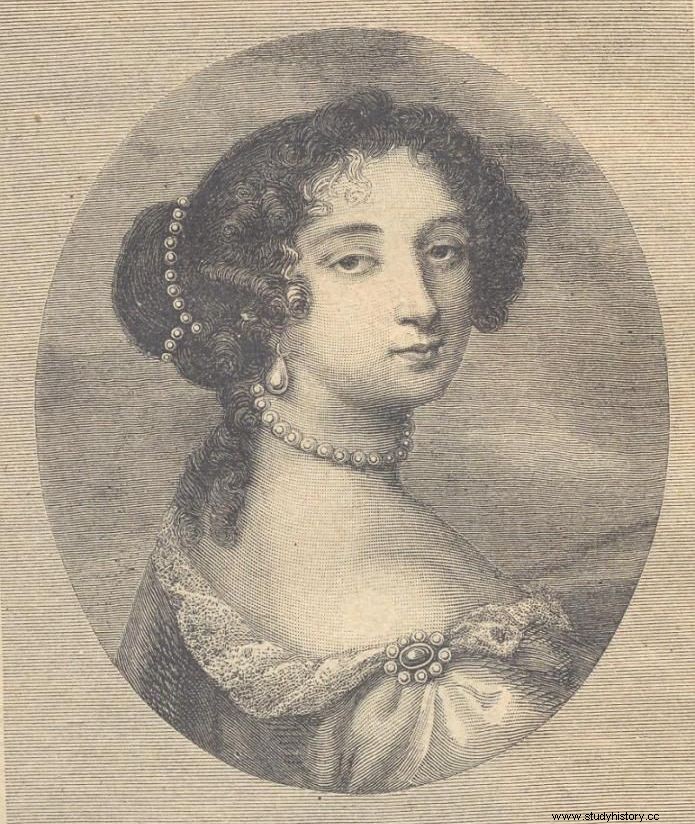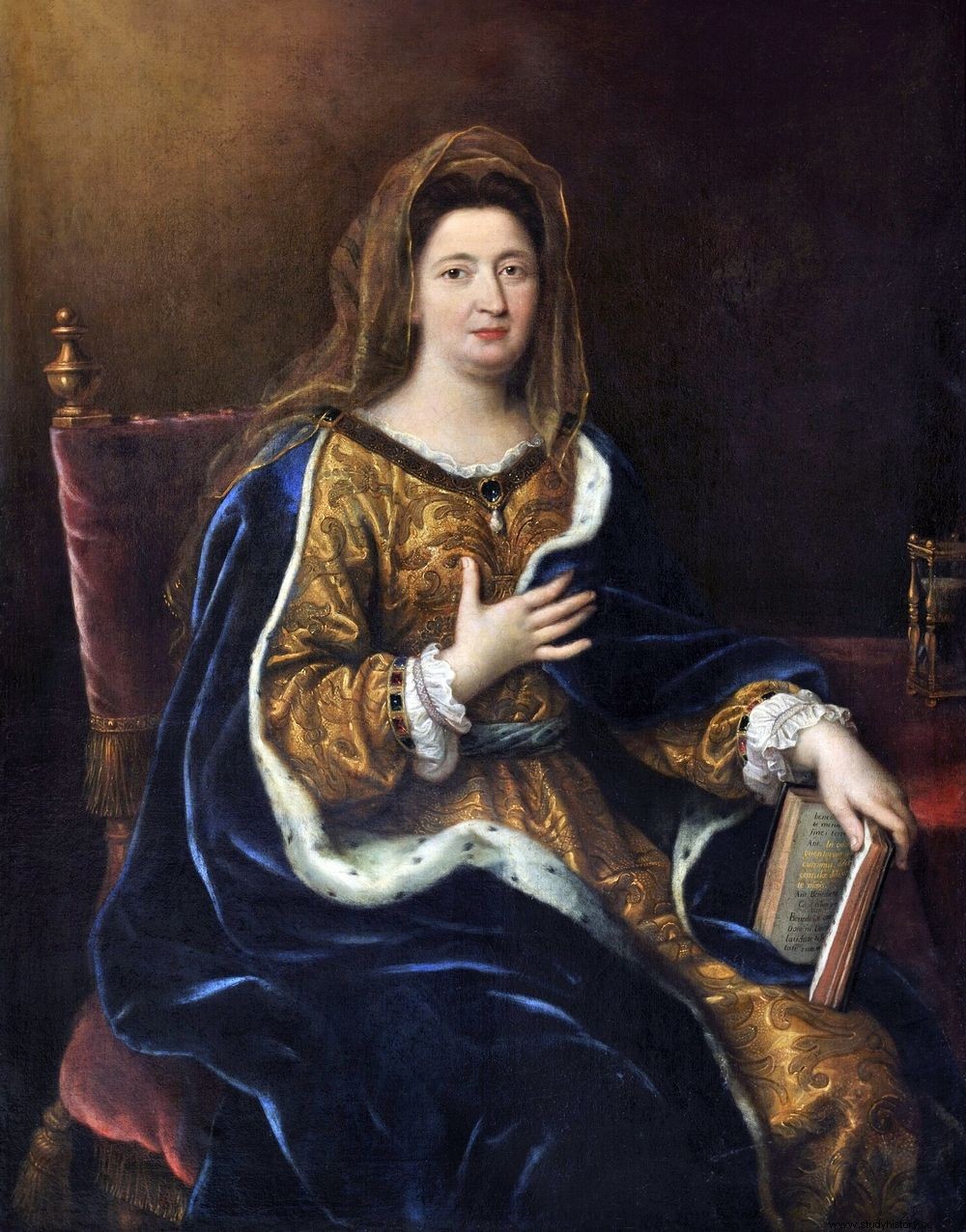Her parents abandoned her. The godmother ordered turkeys to be fed. She never complained, even when she had to leave the prom ahead of time to look after someone else's children. And although she did not try to do so, she caught the monarch's eye. And then they lived a long life ... and judge for yourself if they were happily.
When Charles Perrault published Cinderella in 1697, many French people must have thought he was inspired by reality. More precisely:the story of the woman who won the heart of the Sun King and became his wife.
She was beautiful, hardworking, but poor girl…
Franciszka d'Aubigné was born in November 1635 in ... prison where her father Constant was sitting. A pregnant mother voluntarily accompanied her husband. The girl's grandfather was Agrippa d'Aubigné, an implacable Huguenot. He allegedly put a curse on his son, who was a counterfeiter of money, a debauchee and a traitor.
The mother gave the little girl up to her sister Constanta for upbringing. Franciszek went to a poor family but loving. Her aunt taught her home management. She and her husband raised Franciszka to be a Protestant.

Keep of the castle in Niort. It was in this town that Franciszka was born and baptized - the real Cinderella. And all this because her father was in prison ... (photo:Alex Giraud, license CC BY-SA 3.0).
The happy childhood ended when in 1644 my father left the bars . The parents remembered their daughter and took her to the Lesser Antilles, where they wanted to make a fortune in the cotton and tobacco trade.
Constant was appointed governor of the islet of Marie-Galante. On the spot, however, it turned out that his position was taken by someone else. The father returned to the country, leaving his family behind. During this period, Franciszka suffered a lot from her mother, who tugged her hair until it bled and threw the little girl outside to let the flies settle the wound . When they returned to France two years later, it turned out that my father had just died.
And the fairy godmother turned out to be a stepmother ...
Franciszka was returned to her aunt. Due to the weathered skin of the Caribbean sun, she gained the nickname "Indian woman". She lived quietly until the Countess of Neuillan asked for her. The Countess was the mother of Franciszka's godmother and she was ordered to take care of her.
The godmother's behavior resembled a rather hideous stepmother . The sole purpose of this skimpy bigot was to raise the girl to be a devout Catholic.

Royal Martinique Fort. It is on this Caribbean island that Cinderella spent her "American adventure" (author:François Denis, public domain).
It was in Franciszek's godmother that she experienced "Cinderella" humiliations - hard work and wearing used rags . She later recalled:
though [godmother] was rich enough to have your carriage, I always wore wooden clogs, and only put my shoes on when guests were supposed to be. [I spent] several hours a day herding turkeys.
Miss Aubigné did not intend to stop complaining, but to learn from her experience. And she wanted more and more to break free.
Beauty and the Beast
Franciszka grew into a beautiful maiden - tall, slender and dark-haired. Thanks to her exotic beauty, she aroused male desire. Nevertheless, her first show in the salons was remarkably unsuccessful . There was no real good fairy, so she was dressed according to her purse - in a short, gray dress.
The dowry girl seemed to have only one option in life:entering a convent. Miss Franciszka seized the only other possibility that fate had given her. In 1652 she married Paul Scarron.
Her husband was nothing like a prince charming. He was a debt-ridden poet who tried to discover the philosopher's stone, and he called his home "Penniless Palace". He was easily angry, aggressive and malicious. And almost three times older than Franciszka.
However, the poet's appearance was the worst. Scarron was more like Quasimodo , the humped bell-ringer of Notre Dame, than the lover. Losing the use of his legs, he was sitting in a cage on his reclining chair. He had to be moved to bed for the night. He himself described himself as a person with a Z-shaped physiognomy.
Scarron, overwhelmed by his disease, could not even turn from side to side. Only opium relieved the pain. Nevertheless, Franciszka wrote: I preferred to marry him than to go to a convent . Her fate was about to change ...

"The image of human misery", or Paweł Scarron, Cinderella's first husband (source:public domain).
Scarron, aware of his ugliness, liked to surround himself with beautiful things. His lovely wife who had red lips and beautiful teeth definitely fit the collection.
Many suitors tried to get closer to Franciszka, but she fought them off. Though her marriage was most likely white maintained impeccable moral rigor.
Franciszka lovingly cared for her unbearable husband. It was for her that he began to dress neatly and become less angry. He was bursting with pride in his wife's intelligence he taught Italian and Spanish. He offered the girl something much more permanent than the gifts from the good fairy disappearing after a few hours - education and great contacts.
When Franciszka became a widow in 1660, she lived in poverty again, but she could at least decide about herself. She got a salary from the queen. She also became friends with the princes Richelieu and Albert.

Beautiful Cinderella bravely rejected successive suitors. Francis d'Aubigne in the painting by Nicolas II de Larmessin (source:public domain).
The relationship worked when, in 1667, the Queen offered the widow Scarron the position of a court lady and Spanish teacher in one.
Franciszka had previously raised the children of one of the ladies of the court - the cousin of Louis XIV's new lover, Mrs. Montespan. A pregnant royal mistress persuaded the widow Scarron to assist her in childbirth. Franciszka discreetly took the newborn baby wrapped in the folds of her coat. She went to live with the mammoths and another three of the king's bastards as their foster mother.
You can go to the prom, just be back before midnight…
For four years, Francis hid the existence of the illegitimate offspring of the king, leading a rich social life for the sake of ignorance . She looked after the children at night, often returning home in the morning through the back door. In the evenings she had to attend balls. In her new life, she had beautiful clothes, horses, a carriage, two butlers and a coachman at her disposal.

Mrs. Montespan with the children of her relationship with the king. Contrary to this idyllic vision, the royal mistress was not very interested in her children, leaving their upbringing on Cinderella's shoulders. Picture from 1680 (source:public domain).
After the bastards were officially recognized, Franciszek became a tutor for the next children of the monarchs. Louis XIV was more interested in children than in his lover, and he often came to stay with them himself. It gave a chance to get to know Mrs. Scarron better though at first he was afraid he was boring piety.
And then the prince appeared…
Soon the king appreciated the childless widow loving care of his children. She impressed him when she saved his son from disability. She reminded him of the feeling his mother had felt for him . He himself stated: She knows how to love and it would be nice to be loved by her .
The king discovered the pleasure of talking to Franciszka, he valued her mind and person. He listened to her soothing voice with pleasure. In gratitude, he awarded her the title of Marquis of Maintenon. The mistress was furious that the king preferred to spend time with the governess . However, knowing Franciszka's approach to men, she did not expect any threat from her.

"She knows how to love and it would be nice to be loved by her." Francis in the painting by an unknown author (source:public domain).
She lost her slipper ...
Former French ladies wore squirrel-skin boots. Such material was called vair which sounds the same as verre (glass). This was the beginning of the legend of the glass slipper. And when you think about it, losing a "fur slipper" is much less decent than losing a boot ...
Madame de Montespan soon fell out of favor with the Sun King, and around 1680 Mrs. Maintenon broke her iron resolutions and, by handing over her "slipper", became a royal mistress.
And they lived happily ever after?
The situation of Franciszka unexpectedly changed in 1683, when the queen died. Mrs. Maintenon, 47, wanted to discreetly leave the court. One of the dukes almost forcibly dragged her to Ludwik, saying: It's not time to leave the king, he needs you .
The widowed monarch took Mrs. Maintenon to wife at the end of the year. Due to her low origin, he did not make her an official queen. The marriage was kept secret, and outsiders considered Francisco a public sinner.
Francis did not perform any royal functions and still had to give way to more titled ladies. She endured it with the dignity and modest face of a person who does not have to prove anything.
For thirty-two years of the union, Louis XIV received his ministers in the apartment of Mrs. Maintenon. He decided the fate of France while sitting opposite his wife who was reading or embroidering. She had a great influence on the king. According to an anecdote, when someone said: I don't have anyone [behind me] except Madame de Maintenon , they replied: Madame de Maintenon? It means you have the king himself!

The king's 58-year-old consort still had a lot of charm. Francis in 1694 in a painting by Pierre Mignard (source:public domain).
Francis relieved royal sorrows. She looked after his descendants. She also bought a castle in Saint Cyr, where founded a school for girls from poor noble families giving them a better start in life. In this way, she assumed the honorary role of a fairy for the next generations of Cinderella.
Mrs. Maintenon left Versailles in 1715, just before Louis' death. She didn't want to risk the humiliation of the new regent. She moved to Saint Cyr, where she died four years later. She was the woman who stayed with the Sun King the longest and the only one he had ever asked for forgiveness for her behavior.
